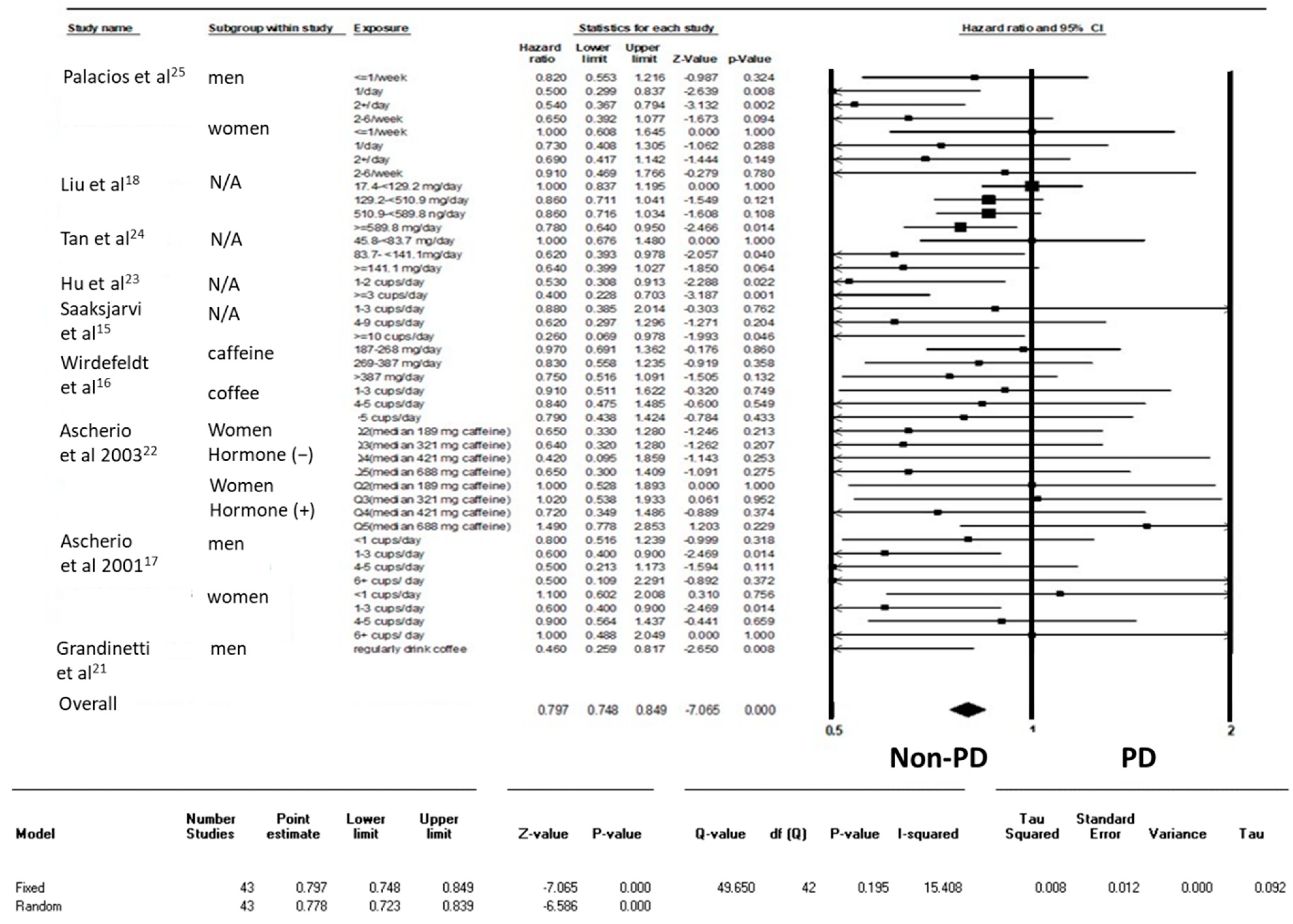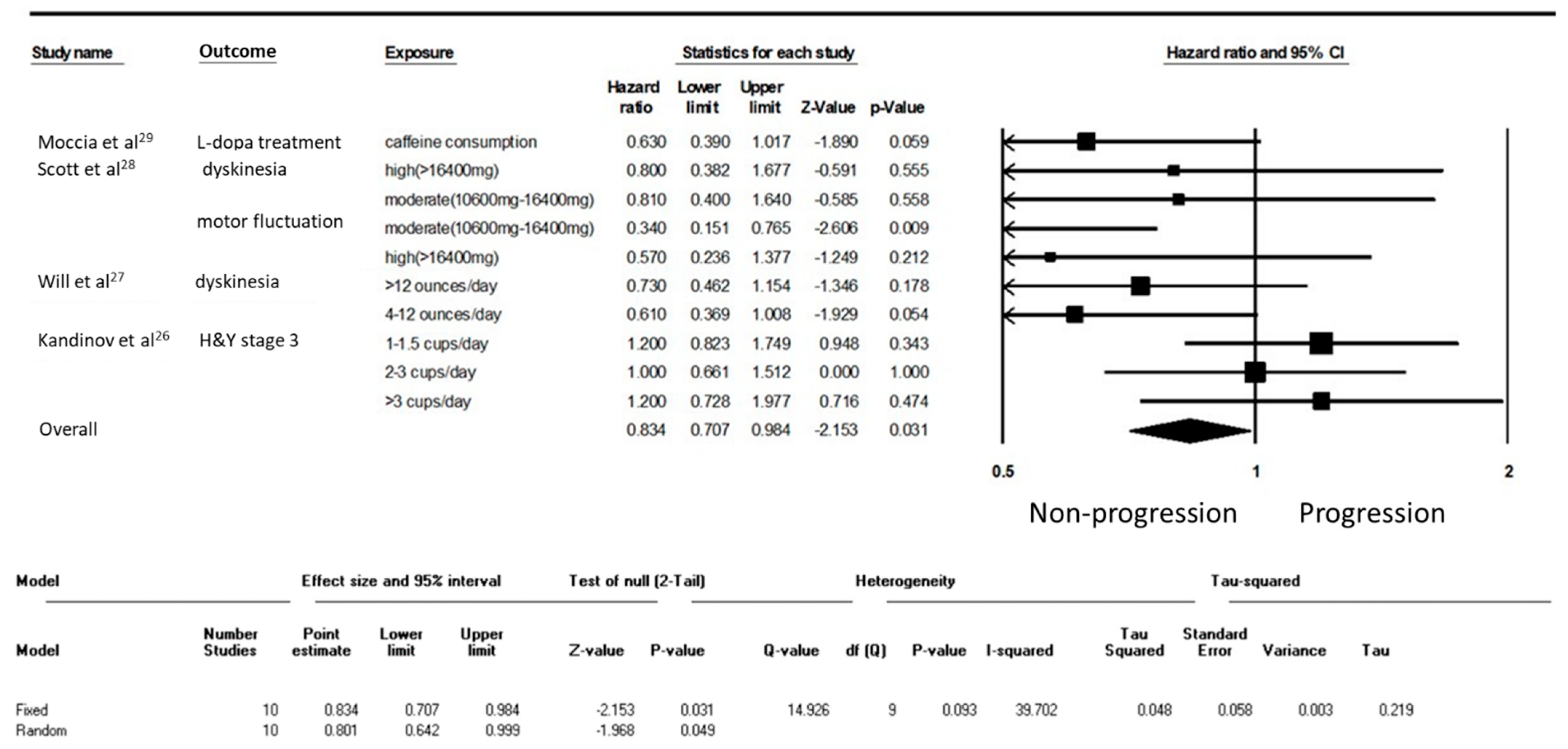Correction: Hong et al. The Effect of Caffeine on the Risk and Progression of Parkinson’s Disease: A Meta-Analysis. Nutrients 2020, 12, 1860
Error in Figure/Table
Reference
- Hong, C.T.; Chan, L.; Bai, C.-H. The Effect of Caffeine on the Risk and Progression of Parkinson’s Disease: A Meta-Analysis. Nutrients 2020, 12, 1860. [Google Scholar] [CrossRef] [PubMed]


| Study Name | Country | Original Cohort (Established-Last Outcome Assessment) | n | Assessment Caffeine Consumption | Amount of Caffeine Consumption | The Diagnosis of PD |
|---|---|---|---|---|---|---|
| Ascherio et al. [17] | USA | Health Professionals’ Follow-Up Study and Nurses’ Health Study (1976 and 1986/1994) | 135,916 | Semiquantitative food-frequency questionnaire (SFFQ) | Caffeine was 137 mg per cup of coffee, 47 mg per cup of tea, 46 mg per can or bottle of cola beverage, and 7 mg per serving of chocolate candy. | Self-report and medical records |
| Ascherio et al. [22] | USA | Nurses’ Health Study (1976/1998) | 121,700 women | Semiquantitative food-frequency questionnaire (SFFQ) | Caffeine was 137 mg per cup of coffee, 47 mg per cup of tea, 46 mg per can or bottle of cola beverage, and 7 mg per serving of chocolate candy. | Medical records |
| Grandinetti et al. [21] | USA | Honolulu Heart Program-Japanese and Okinawan ancestry (1965/1991) | 8006 men | Questionnaires | NA | Medical records |
| Hu et al. [23] | FIN | Four independent cross-sectional population surveys were carried out in five geographic areas of Finland in 1982, 1987, 1992, and 1997 (1982/2002) | 29,335 | Self-administered questionnaire | Cups of coffee | National Social Insurance Institution’s Register |
| Liu et al. [18] | USA | NIH-AARP Diet and Health Study (1995/2010) | 566,401 | Diet History Questionnaire | Nutrient calculation: 1994–1996 US Department of Agriculture’s Continuing Survey of Food Intakes by Individuals. | Interview and copy of medical records |
| Palacios et al. [25] | USA | CPS II–Nutrition cohort (1992/2007) | 184,190 | Food Frequency Questionnaire | 137 and 47 mg per cup of coffee and tea, respectively, 46 mg per can or bottle of cola; and 7 mg per serving of chocolate. | Interview and copy of medical records |
| Sääksjärvi et al. [15] | FIN | Finnish Mobile Clinic Health Examination Survey (1973/1994) | 7246 | Self-administered, health questionnaire | Cups of coffee | National Social Insurance Institution’s Register |
| Tan et al. [24] | SG | Singapore Chinese Health Study (1993/2005) | 63,257 | A validated, semiquantitative food frequency section questionnaire | Singapore Food Composition Table, a food-nutrient database that lists the levels of 96 Nutritive/nonnutritive components (including caffeine) per 100 g of cooked food and beverages | Interview and linkage database to medical record |
| Wirdefeldt et al. [16] | SE | Swedish Twin Registry (1961 and 1973/without clear mentioning) | 52,149 | Questionnaires | Did not provide the formula | Inpatient Discharge Register and Cause of Death Register |
| Study Name | Country | Number of PD | Stage of PD | Assessment Caffeine Consumption | Amount of Caffeine Consumption | Mean Follow-Up Period of Time | Outcome as the Progression of PD |
|---|---|---|---|---|---|---|---|
| Kandinov et al. [26] | IL | 278 | Onset of PD motor symptoms | Interview | The number of cups of coffee per day | 10.3 years | Time from onset to Hoehn and Yahr stage 3 |
| Moccia et al. [29] | IL | 79 | de novo, drug naïve | Caffeine Consumption Questionnaire | i.e., Espresso 1oz = 50 mg caffeine | 4 years | Starting L-dopa treatment |
| Scott et al. [28] | GB | 183 | Newly diagnosed | Verbal interview about the average level of exposure before baseline | Cups of tea: 47 mg caffeine Cup of coffee: 62 mg caffeine | 59 months | 1.Motor fluctuation 2.Dyskinesia |
| Wills et al. [27] | US | 228 | Early PD | questionnaire assessing both current (“in the past week”) and prior (“on average over the past 5 years”) caffeine intake | Coffee (85 mg caffeine/5 oz) Tea (36 mg caffeine/5 oz) Soda (45 mg caffeine/12 oz) | 5.5 years | Dyskinesia |
Disclaimer/Publisher’s Note: The statements, opinions and data contained in all publications are solely those of the individual author(s) and contributor(s) and not of MDPI and/or the editor(s). MDPI and/or the editor(s) disclaim responsibility for any injury to people or property resulting from any ideas, methods, instructions or products referred to in the content. |
© 2023 by the authors. Licensee MDPI, Basel, Switzerland. This article is an open access article distributed under the terms and conditions of the Creative Commons Attribution (CC BY) license (https://creativecommons.org/licenses/by/4.0/).
Share and Cite
Hong, C.T.; Chan, L.; Bai, C.-H. Correction: Hong et al. The Effect of Caffeine on the Risk and Progression of Parkinson’s Disease: A Meta-Analysis. Nutrients 2020, 12, 1860. Nutrients 2023, 15, 699. https://doi.org/10.3390/nu15030699
Hong CT, Chan L, Bai C-H. Correction: Hong et al. The Effect of Caffeine on the Risk and Progression of Parkinson’s Disease: A Meta-Analysis. Nutrients 2020, 12, 1860. Nutrients. 2023; 15(3):699. https://doi.org/10.3390/nu15030699
Chicago/Turabian StyleHong, Chien Tai, Lung Chan, and Chyi-Huey Bai. 2023. "Correction: Hong et al. The Effect of Caffeine on the Risk and Progression of Parkinson’s Disease: A Meta-Analysis. Nutrients 2020, 12, 1860" Nutrients 15, no. 3: 699. https://doi.org/10.3390/nu15030699
APA StyleHong, C. T., Chan, L., & Bai, C.-H. (2023). Correction: Hong et al. The Effect of Caffeine on the Risk and Progression of Parkinson’s Disease: A Meta-Analysis. Nutrients 2020, 12, 1860. Nutrients, 15(3), 699. https://doi.org/10.3390/nu15030699





